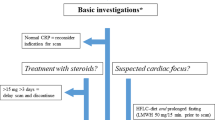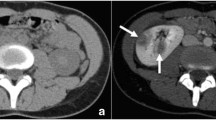Abstract
Renal scintigraphy is a useful tool in diagnosis and management of various nephro-urological conditions. Tc-99m dimercaptosuccinic acid renal scintigraphy (Tc-99m-DMSA), Tc-99m mercaptoacetyltriglycine (Tc-99m-MAG3) or Tc-99m diethylenetriaminepentaacetic acid (Tc-99m-DTPA) dynamic renal scintigraphy, and Radionuclide micturating cystography are the common scans used in children with kidney diseases. These studies are minimally invasive, easily available, and offer both anatomic details and functional information required for thorough evaluation. At the same time, it is essential to have appropriate knowledge to interpret these studies and be aware of their limitations and pitfalls. The advent of Positron emission tomography-computed tomography/magnetic resonance imaging (PETCT/MRI) has broadened the scope of nuclear medicine. This article focuses on the technique, interpretation, indication and recent practice guidelines of renal scintigraphy in children with kidney diseases.
Similar content being viewed by others
References
Piepsz A, Colarinha P, Gordon I, Hahn K, Olivier P, Roca I, et al. Guidelines for 99mTc-DMSA scintigraphy inchildren. Eur J Nucl Med. 2001;28:BP37–BP41.
Mandell GA, Eggli DF, Gilday DL, Heyman S, Leonard JC, Miller JH, et al. Society of Nuclear Medicine Procedure Guidelines for Renal Cortical Scintigraphy in Children. Available from: www.snmmi.org/Quality_&_Practice/Guidance/Procedure_Standards. Accessed March 5, 2018.
Weyer K, Nielsen R, Petersen SV, Christensen EI, Rehling M, Birn H. Renal uptake of 99mTc-dimercaptosuccinic acid is dependent on normal proximal tubule receptormediated endocytosis. J Nucl Med. 2013;54:159–65.
Müller-Suur R, Gutsche HU. Reabsorption of technetium-99m-DMSA. J Nucl Med. 1995;36:1654–8.
Gelfand MJ, Parisi MT, Treves ST, Pediatric Nuclear Medicine Dose Reduction Workgroup. Pediatric Radiopharmaceutical Administered Doses: 2010 North American Consensus Guidelines. J Nucl Med. 2011;52:318–22.
Lassmann M, Biassoni L, Monsieurs M, Franzius C, Jacobs F, Dosimetry E, et al. The new EANM paediatric dosage card. Eur J Nucl Med Mol Imaging. 2007;34:796.
Lassmann M, Treves ST, Group ESPDHW. Pediatric radiopharmaceutical administration: harmonization of the 2007 EANM paediatric dosage card (version 1.5.2008) and the 2010 North America consensus guidelines. Eur J Nucl Med Mol Imaging. 2014;41:1036–41.
Jang SJ. Nuclear medicine in pediatric urology. Child Kidney Dis. 2015; 19:14–22.
Gordon I, Piepsz A, Sixt R. Guidelines for standard and diuretic renography in children. Eur J Nucl Med Mol Imaging. 2011;38:1175–88.
Santra A, Sharma P, Malhotra A, Kumar R. Role of nuclear medicine techniques in the management of disease in infants. J Neonatol. 2008. 22:194–204.
Shulkin B, Mandell GA, Cooper JA, Leonard JC, Majid M, Parisi MT, et al. Society of nuclear medicine procedure guidelines for diuretic renography in children. J Nuclear Med Tech. 2008;36:162–7.
Stabin MG, Gelfand MJ. Dosimetry of pediatric nuclear medicine procedures. Q J Nucl Med. 1998;42:93–112.
Ziessman H, Malley JO, Thrall J, Fahey FH. Nuclear Medicine: The Requisites. 4th ed. Philadelphia:Elsevier; 2014. p.175-83.
Textor SC. Current approaches to renovascular hypertension. Med Clin North Am. 2009;93:717–32.
Taylor AT, Fletcher JW, Nally JV, Blaufox MD, Dubovsky EV, Fine EJ, et al. Procedure guidelines for diagnosis of renovascular hypertension. J Nucl Med. 1998;39:1297–302.
Mandell GA, Eggli DF, Gilday DL, Heyman S, Leonard JC, Miller JH, et al. Society of Nuclear Medicine Procedure Guideline for Radionuclide Cystograpy in Children. Avail-able from: www.snmmi.org/Quality_&_Practice/Guidance/Procedure_Standards. Accessed March 05, 2018.
Conway JJ, King LR, Belman AB, Thorson T. Detection of vesicoureteral reflux with radionuclide cystography. Am J Roentgenol. 1972;115:720–7.
Lebowitz RL, Olbing H, Parkkulainen KV, Smellie JM, Tamminen-Möbius TE. International system of radiographic grading of vesicoureteric reflux. Pediatr Radiol. 1985;15:105–9.
Fettich J, Colarinha P, Fischer S, Frökier J, Gordon I, Hahn K, et al. Guidelines for direct radionuclide cystography in children. Eur J Nucl Med Mol Imaging. 2003;30:B39–B44.
Piepsz A, Colarinha P, Gordon I, Hahn K, Olivier P, Sixt R, et al. Guidelines for Glomerular Filtration Rate Determination in Children. Available from: www.eanm.org/publications/guidelines/gl_paed_gfrd.pdf. Accessed March 05, 2018.
Smith T, Gordon I. An update of radiopharmaceutical schedules in children. Nucl Med Commun. 1998;19: 1023–36.
Bröchner-Mortensen J, Haahr J, Christoffersen J. A simple method for accurate assessment of the glomerular filtration rate in children. Scand J Clin Lab Invest. 1974;33:139–43.
Chantler C, Barratt TM. Estimation of glomerular filtration rate from plasma clearance of 51 Chromium Edetic Acid. Arch Dis Child. 1972;47:613–7.
Bröchner-Mortensen J. Current status on assessment and measurement of glomerular filtration rate. Clin Physiol.1985;5:1–17.
Ham HR, Piepsz A. Estimation of glomerular filtration rate in infants and children using a simple plasma sample method. J Nucl Med. 1991;32:1294–7.
Piepsz A, Pintelon H, Ham HR. Estimation of normal 51Cr EDTA clearance in children. Eur J Nucl Med. 1994;21: 12–6.
National Institute for Health and Clinical Excellence. Urinary Tract Infection in Children: Diagnosis, Treatment and Long-Term Management. Clinical Guideline 54. London: NICE, August 2007. Available from: www.nice.org.uk/guidance/cg54/evidence/full-guidelinepdf-196566877. Accessed March 5, 2018.
Subcommittee on Urinary Tract Infection, Steering Committee on Quality Improvement and Management. Roberts KB. Urinary Tract Infection: Clinical Practice Guideline for the Diagnosis and Management of the Initial UTI in Febrile Infants and Children 2 to 24 Months. Pediatrics. 2011;128:595–610.
Vijayakumar M, Kanitkar M, Nammalwar BR, Bagga A. Revised Statement on Management of Urinary Tract Infections. Indian Pediatr. 2011;48:709–17.
Sinha A, Bagga A, Krishna A, Bajpai M, Srinivas M, Uppal R, et al. Revised Guidelines on Management of Antenatal Hydronephrosis. Indian J Nephrol. 2013;23:83–97
Tullus K, Brennan E, Hamilton G, Lord R, McLaren CA, Marks SD, et al. Renovascular hypertension in children. Lancet. 2008;371:1453–63.
Mendichovszky I, Solar BT, Smeulders N, Easty M, Biassoni L. Nuclear medicine in pediatric nephro-urology: an overview. Semin Nucl Med. 47:204–28.
Walter F, Czernin J, Hall T, Allen-Auerbach M, Walter MA, Dunkelmann S, et al. Is there a need for dedicated bone imaging in addition to 18F-FDG PET/CT imaging inpediatric sarcoma patients? J Pediatr Hematol Oncol. 2012;34:131–6.
Volker T, Denecke T, Steffen I, Misch D, Schönberger S, Plotkin M, et al. Positron emission tomography for staging of pediatric sarcoma patients: Results of a prospective multicenter trial. J Clin Oncol. 2007;25: 5435–41.
Biassoni L. Pitfalls and limitations of radionuclide renal imaging in Pediatrics. Semin Nucl Med. 2015;45:411–27.
Ma YC, Zuo L, Zhang CL, Wang M, Wang RF, Wang HY. Comparison of 99mTc-DTPA renal dynamic imaging with modified MDRD equation for glomerular filtration rate estimation in Chinese patients in different stages of chronic kidney disease. Nephrol Dial Transplant. 2007;22:417–23.
Rodby RA, Ali A, Rohde RD, Lewis EJ. Renal scanning 99mTc diethylene-triaminepentaacetic acid glomerular filtration rate (GFR) determination compared with iothalamate clearance GFR in diabetics. Am J Kidney Dis. 1992;20:569–73.
Itoh K. Comparison of methods for determination of glomerular filtration rate: Tc-99m-DTPA renography, predicted creatinine clearance method and plasma sample method. Ann Nuclear Med. 2003;17:561–65.
Author information
Authors and Affiliations
Corresponding author
Rights and permissions
About this article
Cite this article
Dhull, R.S., Joshi, A. & Saha, A. Nuclear Imaging in Pediatric Kidney Diseases. Indian Pediatr 55, 591–597 (2018). https://doi.org/10.1007/s13312-018-1303-7
Published:
Issue Date:
DOI: https://doi.org/10.1007/s13312-018-1303-7




